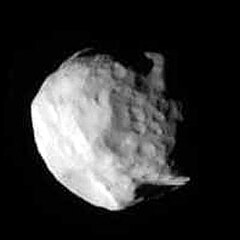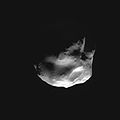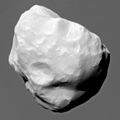Helena (księżyc)
| ||
 Zdjęcie Heleny z sondy Cassini | ||
| Planeta | Saturn | |
| Odkrywca | P. Laques i J. Lecacheux | |
| Data odkrycia | 1 marca 1980 | |
| Tymczasowe oznaczenie | S/1980 S 6 | |
| Charakterystyka orbity | ||
| Półoś wielka | 377 444 km[1] | |
| Mimośród | 0,0000[1] | |
| Okres obiegu | 2,737 d[1] | |
| Nachylenie do płaszczyzny Laplace’a | 0,213°[1] | |
| Długość węzła wstępującego | 163,112°[1] | |
| Argument perycentrum | 33,134°[1] | |
| Anomalia średnia | 43,186°[1] | |
| Własności fizyczne | ||
| Wymiary | 36 × 32 × 30 km | |
| Okres obrotu wokół własnej osi | synchroniczny | |
| Albedo | 1,67 ± 0,20 | |
| Jasność obserwowana (z Ziemi) | 18m | |
Helena (Saturn XII) – mały, lodowy księżyc Saturna, odkryli go Pierre Laques i Jean Lecacheux w 1980 roku z obserwatorium naziemnego w Pic du Midi.
Jego nazwa pochodzi od Heleny Trojańskiej, postaci z mitologii greckiej. Helena porusza się po tej samej orbicie co dużo masywniejsza Dione, w punkcie Lagrange’a L4 na orbicie tego księżyca, jest więc tzw. księżycem trojańskim.
Na powierzchni tego księżyca znajdują się zarówno góry i kratery, jak też niezwykle gładkie, pokryte smugami obszary.
Galeria
Zobacz też
- chronologiczny wykaz odkryć planet, planet karłowatych i ich księżyców w Układzie Słonecznym
- księżyce Saturna – zestawienie podstawowych danych
- (101) Helena
Przypisy
Linki zewnętrzne
- Księżyc Saturna Helene widziany przez sondę Cassini w serwisie APOD: Astronomiczne zdjęcie dnia
- Helene. W: Księżyce Układu Słonecznego [on-line]. [dostęp 2016-02-08]. [zarchiwizowane z tego adresu (2011-09-09)].
- Helene (ang.). W: Solar System Exploration [on-line]. NASA. [dostęp 2018-12-26].
Media użyte na tej stronie
This is a revised version of Solar_System_XXIX.png.
A photo taken by the Cassini spacecraft showing Saturn's moon Helene with the atmosphere of the planet in the background. The image was taken in visible light with the Cassini spacecraft narrow-angle camera. The view was acquired at a distance of approximately 19,000 kilometers (12,000 miles) from Helene.
Raw Narrow Angle Camera image of Helene. Taken by Cassini-Huygens on July 20, 2007 from 40,211 km with clear filters. Adapted from source image (cropped and contrast adjusted).
Saturn Cassini-Huygens (NASA)
Instrument: Imaging Science Subsystem - Narrow Angle
Saturn's peaceful beauty invites the Cassini spacecraft for a closer look in this natural color view, taken during the spacecraft's approach to the planet. By this point in the approach sequence, Saturn was large enough that two narrow angle camera images were required to capture an end-to-end view of the planet, its delicate rings and several of its icy moons. The composite is made entire from these two images.
Moons visible in this mosaic: Epimetheus (116 kilometers, 72 miles across), Pandora (84 kilometers, 52 miles across) and Mimas (398 kilometers, 247 miles across) at left of Saturn; Prometheus (102 kilometers, 63 miles across), Janus (181 kilometers, 113 miles across) and Enceladus (499 kilometers, 310 miles across) at right of Saturn.
The images were taken on May 7, 2004 from a distance of 28.2 million kilometers (17.6 million miles) from Saturn. The image scale is 169 kilometers (105 miles) per pixel. Moons in the image have been brightened for visibility.
The Cassini-Huygens mission is a cooperative project of NASA, the European Space Agency and the Italian Space Agency. The Jet Propulsion Laboratory, a division of the California Institute of Technology in Pasadena, manages the Cassini-Huygens mission for NASA's Office of Space Science, Washington, D.C. The Cassini orbiter and its two onboard cameras, were designed, developed and assembled at JPL. The imaging team is based at the Space Science Institute, Boulder, Colo.
For more information, about the Cassini-Huygens mission visit, http://saturn.jpl.nasa.gov and the Cassini imaging team home page, http://ciclops.org.The small moon Helene (33 kilometers, 21 miles across) leads Dione by 60 degrees in the moons' shared orbit. Helene is a "Trojan" moon of Dione, named for the Trojan group of asteroids that orbit 60 degrees ahead of and behind Jupiter as it circles the Sun.
The image was taken in visible light with the Cassini spacecraft narrow-angle camera on Nov. 24, 2008 at a distance of approximately 68,000 kilometers (42,000 miles) from Helene and at a Sun-Helene-spacecraft, or phase, angle of 30 degrees. Image scale is 408 meters (1,338 feet) per pixel.
The Cassini Equinox Mission is a joint United States and European endeavor. The Jet Propulsion Laboratory, a division of the California Institute of Technology in Pasadena, manages the mission for NASA's Science Mission Directorate, Washington, D.C. The Cassini orbiter was designed, developed and assembled at JPL. The imaging team consists of scientists from the US, England, France, and Germany. The imaging operations center and team lead (Dr. C. Porco) are based at the Space Science Institute in Boulder, Colo.
For more information about the Cassini Equinox Mission visit http://ciclops.org, http://www.nasa.gov/cassini and http://saturn.jpl.nasa.gov.
The original NASA image has been modified by cropping, doubling the linear pixel density and sharpening.This image of Helene was acquired by the Voyager 2 spacecraft on August 25, 1981.
This raw, unprocessed image of Helene was taken by Cassini on March 3, 2010.
The image was taken in visible light with the Cassini spacecraft wide-angle camera. The view was acquired at a distance of approximately 1,900 kilometers (1,200 miles) from Helene. Image scale is 235 meters (770 feet) per pixel.
The Cassini Equinox Mission is a joint United States and European endeavor. The Jet Propulsion Laboratory, a division of the California Institute of Technology in Pasadena, manages the mission for NASA's Science Mission Directorate, Washington, D.C. The Cassini orbiter was designed, developed and assembled at JPL. The imaging team consists of scientists from the US, England, France, and Germany. The imaging operations center and team lead (Dr. C. Porco) are based at the Space Science Institute in Boulder, Colo.
For more information about the Cassini Equinox Mission visit http://ciclops.org, http://www.nasa.gov/cassini and http://saturn.jpl.nasa.gov.
The original NASA image has been modified by cropping, doubling the linear pixel density and reducing midtone contrast. These edits were made to center the feature of interest, remove excess black background and bring out detail which is hard to see in the small original.









